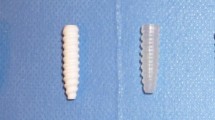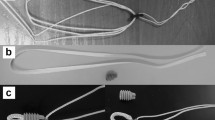Abstract
Introduction: The purpose of our study was to evaluate and compare the primary fixation strength of a novel bioabsorbable two shell expansion bolt (EB) with that of a well-established interference screw-fixation technique in hamstring reconstruction of the anterior cruciate ligament. Materials and methods: Thirty calf tibia plateaus (age 5–6 months) were assigned to three groups: In group I (n=10) triple-stranded hamstring grafts were fixed with titanium interference screws (7 mm thread / 8 mm head × 25 mm). Specimens of group II (n=10) received bioabsorbable poly-L-lactide interference screws (8×23 mm). In group III (n=10), the grafts were fixed using bioabsorbable poly-D,L-lactide expansion bolts (5.8/8.5/10 mm × 35 mm). The tensile axis was placed parallel to the bone tunnel. The construction was then loaded until failure under a displacement rate of 1 mm per second. Results: There were no significant differences concerning the maximum pullout force (group I: 357 N ± 61; group II: 326 N ± 92; group III: 343 N ± 55). In case of the expansion bolt, we found the stiffness to be higher (61 N/mm) when compared to group I (48 N/mm), and group II (52 N/mm) (P<0.01 I vs. III). Using interference screws, we were able to demonstrate a strong correlation between torque and pullout forces (group I: r2=0.7; group II: r2=0.92). Ruptures of the suturing material occurred only in groups I and II. Conclusion: We conclude that hamstring graft fixation, using the presented expansion bolt, demonstrates fixation strength similar to the established screw fixation and can therefore be regarded as a reasonable alternative fixation method. Especially, since some specific disadvantages of screw fixation can be prevented by application of the bolt fixation.





Similar content being viewed by others
References
Aune AK, Ekeland A, Cawley PW (1998) Interference screw fixation of hamstring vs patellar tendon grafts for anterior cruciate ligament reconstruction. Knee Surg Sports Traumatol Arthrosc 6:99–102
Barber FA, Elrod BF, McGuire DA, Paulos LE (1995) Preliminary results of an absorbable interference screw. Arthroscopy 11:537–548
Bartlett RJ, Clatworthy MG, Nguyen TN (2001) Graft selection in reconstruction of the anterior cruciate ligament. J Bone Joint Surg Br 83: 625–634
Bellemans J, Eid T, Fabry G (1999) A modified technique for tibial interference screw fixation of hamstring anterior cruciate ligament grafts. Arthroscopy 15:669–671
Brown CH, Hecker AT, Hipp JA, Myers ER, Hayes WC (1993) The biomechanics of interference screw fixation of patellar tendon anterior cruciate ligament grafts. Am J Sports Med 21:880–886
Brown GA, Pena F, Grontvedt T, Labadie D, Engebretsen L (1996) Fixation strength of interference screw fixation in bovine, young human, and elderly human cadaver knees: influence of insertion torque, tunnel-bone block gap, and interference. Knee Surg Sports Traumatol Arthrosc 3:238–244
Caborn DN, Coen M, Neef R, Hamilton D, Nyland J, Johnson DL (1998) Quadrupled semitendinosus-gracilis autograft fixation in the femoral tunnel: a comparison between a metal and a bioabsorbable interference screw. Arthroscopy 14:241–245
Cowin S, Van Buskirk W, Ashmann R (1987) Properties of bone. In: Shalak R, Chien S (eds) Handbook of bioengineering, chap 3. McGraw-Hill, New York
Hackl W, Benedetto KP, Hoser C, Künzel KH, Fink C (2000) Is screw divergence in femoral bone-tendon-bone graft fixation avoidable in anterior cruciate ligament reconstruction using a single-incision technique? A radiographically controlled cadaver study. Arthroscopy 16:640–647
Hamada M, Shino K, Mitsuoka T, Abe N, Horibe S (1998) Cross-sectional area measurement of the semitendinosus tendon for anterior cruciate ligament reconstruction. Arthroscopy 14:696–701
Ishibashi Y, Rudy TW, Livesay GA, Stone JD, Fu FH, Woo SL (1997) The effect of anterior cruciate ligament graft fixation site at the tibia on knee stability: evaluation using a robotic testing system. Arthroscopy 13: 177–182
Johnson LL, van Dyk GE (1994) Arthroscopically monitored ACL reconstruction: compaction drilling and compression screw. In: Feagin JAJ (ed) The crucial ligaments: diagnosis and treatment of ligamentous injuries about the knee, 2nd edn. Churchill Livingstone, New York, pp 555–593
Jomha NM, Raso VJ, Leung P (1993) Effect of varying angles on the pullout strength of interference screw fixation. Arthroscopy 9:580–583
Kousa P, Jarvinen TL, Vihavainen M, Kannus P, Jarvinen M (2003) The fixation strength of six hamstring tendon graft fixation devices in anterior cruciate ligament reconstruction. Part II: tibial site. Am J Sports Med 31: 182–188
L’Insalata JC, Klatt B, Fu FH, Harner CD (1997) Tunnel expansion following anterior cruciate ligament reconstruction: a comparison of hamstring and patellar tendon autografts. Knee Surg Sports Traumatol Arthrosc 5:234–238
Maeda A, Shino K, Horibe S, Nakata K, Buccafusca G (1996) Anterior cruciate ligament reconstruction with multistranded autogenous semitendinosus tendon. Am J Sports Med 24:504–509
Magen HE, Howell SM, Hull ML (1999) Structural properties of six tibial fixation methods for anterior cruciate ligament soft tissue grafts. Am J Sports Med 27:35–43
Magen HE, Hull ML, Howell SM (1998) Comparison of structural and mechanical properties of bovine and human tendons. In: Proceedings of Third World Congress of Biomechanics, Sapporo, Japan, pp 126
Marti C, Imhoff AB, Bahrs C, Romero J (1997) Metallic versus bioabsorbable interference screw for fixation of bone-patellar tendon-bone autograft in arthroscopic anterior cruciate ligament reconstruction A preliminary report. Knee Surg Sports Traumatol Arthrosc 5:217–221
Morgan CD, Kalmam VR, Grawl DM (1995) Isometry testing for anterior cruciate ligament reconstruction revisited. Arthroscopy 11:647–659
Pena F, Grontvedt T, Brown GA, Aune AK, Engebretsen L (1996) Comparison of failure strength between metallic and absorbable interference screws. Influence of insertion torque, tunnel-bone block gap, bone mineral density, and interference. Am J Sports Med 24:329–334
Schroeder FJ (1999) Reduction of femoral interference screw divergence during endoscopic anterior cruciate ligament reconstruction. Arthroscopy 15: 41–48
Shellock FG, Mink JH, Curtin S, Friedman MJ (1992) MR imaging and metallic implants for anterior cruciate ligament reconstruction: assessment of ferromagnetism and artifact. J Magn Reson Imaging 2:225–228
Shino K, Pflaster DS (2000) Comparison of eccentric and concentric screw placement for hamstring graft fixation in the tibial tunnel. Knee Surg Sports Traumatol Arthrosc 8:73–75
Steiner ME, Hecker AT, Brown CH, Hayes WC (1994) Anterior cruciate ligament graft fixation. Comparison of hamstring and patellar tendon grafts. Am J Sports Med 22:240–246; discussion 246–247
Suh JS, Jeong EK, Shin KH, Cho JH, Na JB, Kim DH, Han CD (1998) Minimizing artifacts caused by metallic implants at MR imaging: experimental and clinical studies. AJR Am J Roentgenol 171:1207–1213
Tomita F, Yasuda K, Mikami S, Sakai T, Yamazaki S, Tohyama H (2001) Comparisons of intraosseous graft healing between the doubled flexor tendon graft and the bone-patellar tendon-bone graft in anterior cruciate ligament reconstruction. Arthroscopy 17:461–476
Weiler A, Hoffmann R, Bail HJ, Rehm O, Südkamp NP (1999) Tendon Healing in a Bone Tunnel: histological Analysis After Biodegradable Interference Fit Fixation. Arthroscopy 15:548–549
Weiler A, Hoffmann RF, Bail HJ, Rehm O, Südkamp NP (2002) Tendon healing in a bone tunnel. Part II: Histologic analysis after biodegradable interference fit fixation in a model of anterior cruciate ligament reconstruction in sheep. Arthroscopy 18:124–135
Weiler A, Hoffmann RF, Siepe CJ, Kolbeck SF, Südkamp NP (2000) The influence of screw geometry on hamstring tendon interference fit fixation. Am J Sports Med 28:356–359
Weiler A, Hoffmann RF, Stähelin AC, Bail HJ, Siepe CJ, Südkamp NP (1998) Hamstring tendon fixation using interference screws: a biomechanical study in calf tibial bone. Arthroscopy 14:29–37
Weiler A, Hoffmann RF, Südkamp NP, Siepe CJ, Haas NP (1999) Ersatz des vorderen Kreuzbandes: Biomechanische Untersuchungen zur Patellar- und Semitendinosussehnenverankerung mit einer Poly- (D,L-Laktid)-Interferenzschraube. Unfallchirurg 102:115–123
Weiler A, Peine R, Pashmineh-Azar A, Abel C, Südkamp NP, Hoffmann RF (2002) Tendon healing in a bone tunnel. Part I: Biomechanical results after biodegradable interference fit fixation in a model of anterior cruciate ligament reconstruction in sheep. Arthroscopy 18:113–123
Weiler A, Peine R, Pashmiueh-Azar R, Unterhauser F, Hoffmann R (1998) Tendon to Bone Healing Under Direct Interference Screw Fixation in a Sheep Model. Arthroscopy 14:437–438
Weiler A, Windhagen HJ, Raschke MJ, Laumeyer A, Hoffmann RF (1998) Biodegradable interference screw fixation exhibits pull-out force and stiffness similar to titanium screws. Am J Sports Med 26:119–126
Weimann A, Rodieck M, Zantop T, Hassenpflug J, Petersen W, (2005) Primary stability of hamstring graft fixation with biodegradable suspension versus interference screws. Arthroscopy 21:266–274
Acknowledgements
The authors would like to thank Arthrex Inc., Naples, FL, USA and Smith&Nephew Inc., Carlsbad, CA, USA for providing us with the test implants. This study was supported by the University of Munich Research Fund, and by the Board of Editors of the Münchner Medizinische Wochenschrift.
Author information
Authors and Affiliations
Corresponding author
Rights and permissions
About this article
Cite this article
Piltz, S., Dieckmann, R., Meyer, L. et al. Biomechanical evaluation of a bioabsorbable expansion bolt for hamstring graft fixation in ACL reconstruction: an experimental study in calf tibial bone. Arch Orthop Trauma Surg 125, 577–584 (2005). https://doi.org/10.1007/s00402-005-0007-3
Received:
Published:
Issue Date:
DOI: https://doi.org/10.1007/s00402-005-0007-3




